Do loyalty programs really work? Sure, they’re everywhere—most of us have signed up for one. But here’s the catch: while they might attract customers at first, many programs lose steam fast. The numbers speak for themselves—most loyalty programs fail within two years. Why? Because the excitement fades, customer interest drops, and engagement slows to a crawl.
Sound familiar? Your customers signed up eagerly but stopped caring after a while. It’s a common problem. Even though 72% of shoppers say they spend more with brands they love, nearly 70% still don’t feel truly loyal. That’s a serious disconnect.
So, what’s going wrong? And, more importantly, how can businesses turn things around? This article dives into the key mistakes businesses make with loyalty programs and the practical strategies to fix them.
7+ Pitfalls Why Loyalty Program Fails to Avoid
Loyalty programs can be powerful tools to retain and reward customers, but too often, they need to catch up to their potential. Businesses can build stronger, more successful customer relationships by understanding and avoiding the most common pitfalls.
Lack of Clear Goals in Your Loyalty Program
Lack of clear goals is a major reason loyalty programs fail. Indeed, you will only know when you will arrive if you have a clear destination. The same is true of loyalty programs. Without clear, realistic goals, your program is likely to fail.
Why it happens?
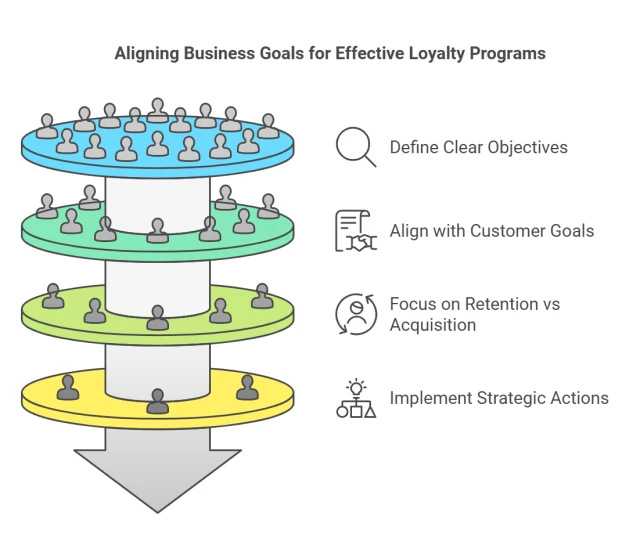
Image: Why do you need a clear goal for your loyalty program?
Clear goals save time and keep everyone focused. However, unclear or unrealistic goals waste resources and confuse your team.
Here’s an example: Many businesses struggle with loyalty programs. Should they focus on getting new customers or keeping current ones? Retention is often cheaper, but a survey showed that 82% of B2B marketers prioritize acquisition over retention. This lack of focus can hurt your strategy.
Furthermore, many brands don’t align their goals with real needs. If your goals, like “boost sales” or “grow market share,” are unclear, your program will not connect with customers.
Clear goals matter. They guide your team, sharpen your strategy, and help you deliver real value to your audience.
Common issues:
- Setting vague goals like “improve customer loyalty” without breaking them down into measurable actions.
- Overlooking key metrics, making it hard to track progress. Without tracking sign-up rates or retention, you won’t know if the program is working.
- Setting goals that are too ambitious, leading to burnout, or too conservative, causing minimal impact.
Recommended solution:
Use the SMART criteria—Specific, Measurable, Attainable, Relevant, and Time-based—to set clear and actionable goals:
- Be specific: “We will offer a points-based reward system for repeat purchases.”
- Trackable metrics: “Boost loyalty program sign-ups by 20% in three months.”
- Make it realistic: “Pilot testing showed a 15% conversion rate, so we aim for 15-20% uptake initially.”
- Ensure relevance: “This goal aligns with our long-term focus on customer retention.”
- Add deadlines: “We’ll measure progress by Q2 of next year.”
Select the Wrong Type of Loyalty Programme
Choosing the wrong type of loyalty program can cause your efforts to backfire, leaving customers confused or disengaged. It’s crucial to select a program type that aligns with your business model and customer preferences.
Types of Loyalty Programs:
| Program Type | Best For | Pros | Cons |
| Points-Based | Frequent, small purchases | Simple, encourages repeat buys | Not ideal for high-priced items |
| Tiered | Building long-term loyalty | Motivates spending, offers perks | Hard to reach higher tiers |
| Subscription-Based | Recurring revenue (e.g., streaming) | Steady income, high engagement | High initial cost, not for everyone |
| Instant Rewards | Memberships or subscriptions | Fast rewards, boosts retention | May lower perceived value |
- Points-Based Programs: Great for frequent, low-value purchases (like coffee shops). Customers earn points and redeem them for rewards.
- Tiered Programs: Perfect for building long-term loyalty. Customers level up (e.g., bronze, silver, gold) based on spending, encouraging higher spending.
- Subscription-Based Programs: Ideal for businesses with steady revenue (like streaming services). Customers pay a recurring fee for exclusive perks.
- Instant Reward Programs: Provide immediate rewards after each purchase, keeping customers engaged and returning.
Recommended solutions:
- Know Your Audience: Choose a program that suits your customers’ shopping habits. Points are great for frequent shoppers, while tiered programs work best for big spenders.
- Instant Rewards: Offer instant rewards to customers who love immediate gratification. This will keep them engaged and coming back.
Ineffective Program Design
When it comes to loyalty programs, design is everything. A poorly designed program can leave customers confused, frustrated, and disengaged.
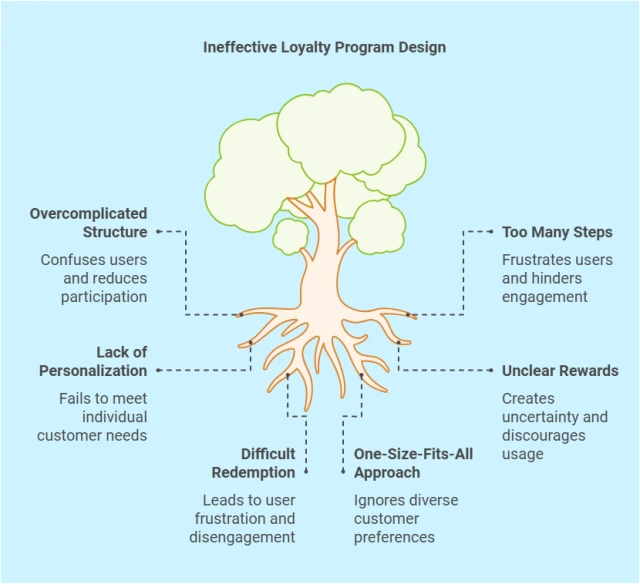
Image: Ineffective designed program leaves customers feeling confused, frustrated, and disengaged
Common Pitfalls:
- Overcomplicated Structure: If your program is too complex, customers will lose interest quickly.
- Unclear Rewards: Hard-to-understand or difficult-to-earn rewards will make customers feel the program isn’t worth their time.
- One-Size-Fits-All: Generic rewards that don’t cater to specific customer needs can make the program feel less engaging.
- Difficult Redemption: A complicated redemption process will discourage customers from participating.
Recommended solutions:
- Keep It Simple: Design an easy-to-understand program where customers know how to earn and redeem rewards.
- Set Clear, Attainable Rewards: Offer rewards that are valuable and accessible, like discounts or exclusive experiences.
- Personalize It: Tailor rewards based on individual customer preferences or behaviors for a deeper connection.
- Ensure Smooth Redemption: Make reward redemption as seamless as possible, whether online or in-store.
Inadequate Communication
Without clear and engaging messages, even the best loyalty program won’t succeed. Communication is the lifeblood that keeps your program running and helps it connect with customers.
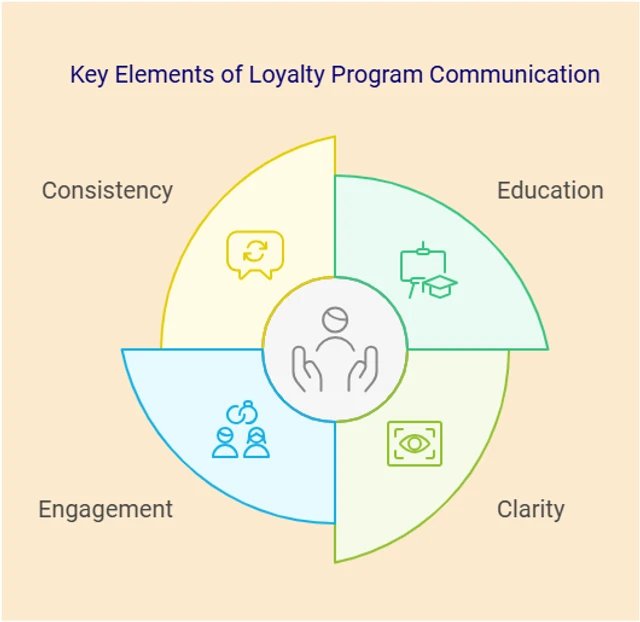
Image: Communication is a key component of a successful loyalty program
Common issues:
- Infrequent Updates: Without regular updates on points, rewards, or new offers, customers may forget about the program.
- Unclear Messaging: Complicated or confusing messaging can lead to frustration, especially when customers don’t understand how to earn or redeem rewards.
- Overloading Customers with Information: Too many updates or irrelevant details can overwhelm customers, causing them to disengage.
- Lack of Omnichannel Support: Limiting communication to one platform might cause you to miss customers where they’re most active.
- Inconsistent Marketing: Misaligned messaging with your brand can confuse customers and erode trust.
Recommended solutions:
- Be Consistent: Ensure your messaging is clear and uniform across all channels, including emails, social media, and in-app notifications.
- Use Targeted Updates: Personalize messages based on customer behavior, like when they’re nearing a reward or have points expiring soon.
- Don’t Overwhelm: Share only relevant information that adds value, avoiding unnecessary updates or jargon.
- Leverage Multiple Channels: Reach customers where they are—via email, SMS, app notifications, and social media.
- Align with the Brand: To ensure a unified customer experience, keep your loyalty program messaging consistent with your overall marketing strategy.
Lack of Value or Differentiation
With so many options, why would anyone engage with your program if they don’t feel it’s worth their time? The key is to provide something different from your competitors and actually make your rewards meaningful. Without that, your program risks getting lost in the noise.

Image: Balancing loyalty programs: Pros keep you grounded, cons can tip the scale
Common Issues:
- Discounts Aren’t Enough: Generic discounts can attract short-term interest, but with multiple loyalty programs available, they don’t foster lasting loyalty.
- Rewards Don’t Match the Value: In industries like luxury goods, rewards that don’t match the high value of purchases can feel disappointing (e.g., points for a $5 reward on a $500 item).
- Invisible Programs: If customers aren’t aware of the program or don’t see the benefits, it can quickly be ignored.
- Too Much Competition: With so many loyalty programs, it’s easy to get lost unless each offers something unique and memorable.
Recommended solutions:
- Offer More than Discounts: Go beyond price reductions—offer exclusive experiences, early access, or personalized rewards that reflect your brand’s values.
- Align Rewards with Customer Interests: Ensure rewards are meaningful and align with the value of the customer’s purchases, offering more substantial rewards for higher-value items.
- Stand Out from the Crowd: Differentiate your program with gamification, limited-edition rewards, or partnerships with complementary brands that resonate with your audience.
- Make Your Program Visible: Actively promote it via social media, email, and your website to keep it in mind for customers.
- Personalize the Experience: Leverage customer data to tailor rewards and experiences, ensuring the program feels relevant and special for each individual.
Lower Customer Engagement, More Distraction
Let’s be real—today’s customers are more distracted than ever. With the constant barrage of notifications, apps, and social media, it’s easy for your loyalty program to get lost in the shuffle.
Common Issues:
- Too Much Noise in the Market: With U.S. consumers averaging 15 loyalty programs, your program risks getting lost if it doesn’t stand out with something unique or exciting.
- Lack of Personalized Experiences: Generic rewards that don’t cater to individual preferences make it easy for customers to ignore the program.
- Overwhelming from Multiple Platforms: Customers are bombarded with notifications and content, leading to fatigue and disengagement unless your program cuts through the noise.
- Unclear Program Structure: If the program’s benefits aren’t obvious, customers may lose interest before even joining.
Recommended solutions:
- Make Your Program Stand Out: To ensure your program grabs attention, offer exclusive rewards, experiences, or content customers can’t get elsewhere.
- Personalize Customer Interactions: Use customer data to offer tailored rewards and experiences that make them feel valued and engaged.
- Reduce the Clutter: Limit the number of messages and focus on high-value communications that highlight the program’s benefits.
- Simplify and Clarify: Make your program easy to understand with clear instructions on how to earn and redeem rewards, eliminating confusion or frustration.
High Operational Costs
Loyalty programs can be a significant investment, but they might become unsustainable when the costs pile up. From technology to rewards and administrative overhead, running a program comes with a hefty price tag. Understanding where the money goes and how to manage it is essential.

Image: Loyalty programs include the balance between costs and engagement
Common Issues:
- Overly Complex Reward Structures: Reward tiers that are too complicated can confuse customers and increase administrative costs, as seen with clients I’ve worked with.
- Underestimating Tech Expenses: Businesses often overlook the ongoing costs of maintaining and upgrading tech tools like CRM systems, apps, and tracking software.
- Inconsistent Engagement: Low customer engagement can lead to ineffective marketing campaigns that drain your budget without delivering returns.
- Unnecessary Rewards: Some rewards, such as extravagant gifts, cost more to deliver than they’re worth, offering little return on investment.
Recommended solutions:
- Simplify the Rewards Structure: Streamlining reward tiers and focusing on engaging options can reduce admin costs and improve customer satisfaction.
- Prioritize Technology ROI: Instead of investing in multiple costly tech tools, choose an all-in-one solution to meet your needs without unnecessary expenses.
- Automate Where Possible: Implement automation tools to reduce operational overhead and allow your team to focus on high-priority tasks.
- Test and Adjust Rewards: Start with smaller, cost-effective rewards and scale up as customer engagement grows to ensure optimal value.
Read our detailed breakdown of Loyalty Program Costs & Fees
Outdated Technology to Support Programme
Technology is crucial for providing seamless customer experiences, tracking valuable data, and scaling operations. If your technology is lagging behind, this can result in inefficiencies, missed opportunities, and frustrated customers.
Common Issues:
- Manual Management: Older in-house loyalty systems often require too much manual effort, leading to slow processes and human error.
- Limited Data Collection: Outdated systems don’t capture sufficient customer data or integrate with modern analytics tools, limiting personalization and targeting capabilities.
- Incompatibility with Third-Party Platforms: Legacy systems often need help integrating with newer tools, hindering the ability to effectively offer cross-platform rewards or track customer engagement.
- Scalability Issues: Older platforms may not scale as your business grows, causing slowdowns or crashes during peak periods, negatively impacting the customer experience.
Recommended solutions:
- Upgrade to Scalable Technology: Switch to cloud-based, third-party loyalty platforms that can handle large customer volumes and integrate seamlessly with other tools.
- Automate Data Collection: Use systems that capture rich customer data in real-time, enabling more personalized and targeted offers.
- Integrate Seamlessly: Ensure your loyalty program integrates with your CRM, eCommerce platform, and marketing automation tools for a unified experience.
- Test and Iterate: Regularly test your technology to ensure it meets current needs and can scale with business growth.
Adapting to Changing Consumer Preferences
What worked for your customers yesterday might not resonate with them today. Adapting your loyalty program to these changes is crucial for maintaining engagement and retaining customers. As preferences evolve, so must your approach to offering rewards, communication, and personalization.
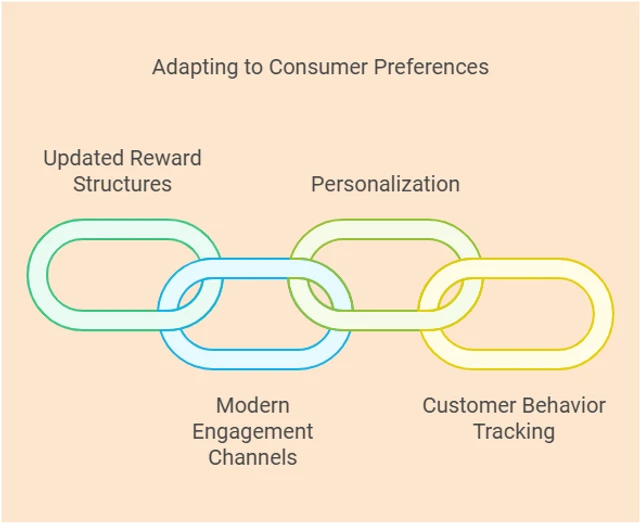
Image: Adapting to these changes is important to maintain engagement and retain customers
Common Issues:
- Sticking to Outdated Reward Structures: Many loyalty programs continue to offer the same rewards, even when customer expectations have changed. For example, a points-based system may no longer appeal to customers who want more exclusive or experiential rewards.
- Ignoring Personalization: Over 80% of consumers prefer personalized experiences, so failing to tailor loyalty programs to individual preferences can lead to disengagement.
- Focusing Too Much on Traditional Channels: Relying solely on email and in-store promotions may result in missed opportunities, as customers increasingly engage through modern channels like mobile apps and social media.
- Not Tracking Customer Behavior Changes: Failing to adapt the program based on data and insights into changing consumer behavior can lead to missed opportunities and lower engagement.
Recommended solutions:
- Use Data to Personalize Rewards: Invest in systems that track customer preferences, offering customized rewards and experiences based on past behavior and purchases.
- Offer Diverse Reward Options: Move beyond traditional points-based systems. Consider offering exclusive experiences, early product access, or even charity donations to meet customers’ desires for meaningful rewards.
- Engage Through Multiple Channels: Ensure your loyalty program is accessible on platforms where your customers are active, including mobile apps, social media, and personalized email campaigns.
- Regularly Update the Program: Continuously gather customer feedback and monitor trends to ensure your program remains fresh, relevant, and engaging.
Challenges in Measuring Effectiveness and Impact
Tracking success isn’t easy without clear data. Without it, you won’t know if your program is working or wasting resources.
In my experience, many brands need more time to measure results. By then, they’ve already missed critical insights. Start tracking early with tools to monitor sign-ups, retention rates, and engagement. Data is the key to success.
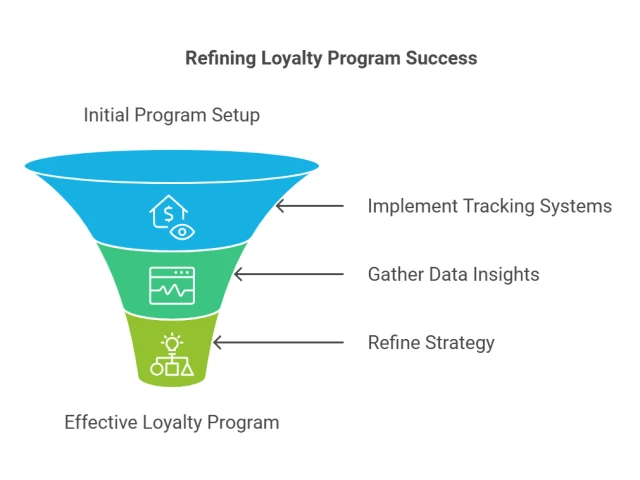
Image: Measuring loyalty program includes setting clear KPIs, centralized data, and also focusing on metrics
Common Issues:
- Lack of clear KPIs: Without defined goals, measuring success is hard, leading to vague assumptions.
- Over-relying on vanity metrics: Metrics like sign-ups and points redeemed can look good but don’t reveal true engagement.
- Inconsistent data sources: Separate platforms create confusion and missing key insights.
- Difficulty measuring long-term impact: Loyalty programs often take time to show real value.
Recommended solutions:
- Set clear KPIs: Define success from the start, such as repeat purchases or retention rates.
- Focus on meaningful metrics: Track engagement, order value, and customer lifetime value for actionable insights.
- Centralize data: Integrate CRM and loyalty analytics for a holistic view of customer behavior.
- Measure short—and long-term results: Track immediate sign-ups and long-term retention to fully understand your program’s success.
Underusing Gamification

Image: Using Gamification in loyalty programs makes customer experience more attractive and engaging
Gamification adds game-like elements, such as rewards, challenges, and levels, to loyalty programs, making the customer experience more engaging. When done right, gamification keeps customers engaged, drives repeat purchases and builds loyalty.
The key is understanding what your customers enjoy. Many programs miss this step, which leads to gamification that feels out of place. Get it right, and you’ll stand out.
Common Issues
- Lack of Meaningful Rewards: Points alone don’t make gamification exciting. Many programs fail to create a real sense of achievement, making gamified elements feel flat.
- Not Tailoring the Experience: A generic approach misses personalization, turning the experience into a checkbox instead of an engaging journey.
- Underestimating Customer Engagement: Gamification can boost engagement by 30%, but only if it actively incentivizes ongoing interaction.
- Infrequent Updates: Without fresh content or new challenges, gamified programs can quickly lose their magic, leading to disengagement.
Recommended solutions:
- Create Tiered Levels and Challenges: Implement a progression system with new rewards or benefits at each level to keep customers engaged.
- Personalize the Experience: Use data to tailor rewards and challenges based on past purchases or customer preferences, making the program feel more personal.
- Make Rewards Meaningful: Ensure rewards are desirable, such as discounts or exclusive experiences, to keep the excitement alive.
- Keep Things Fresh: Regularly update gamified elements with time-limited challenges or seasonal features to prevent stagnation.
- Leverage Shopify Joy Loyalty: You can easily create a gamified program tailored to your brand, track customer progress, and boost engagement using Shopify Joy Loyalty. Check it out here.
Selecting the Best Loyalty Program – Shopify Joy Rewards & Loyalty
- Ratings: 4.9/5
- Total reviews: 1,841
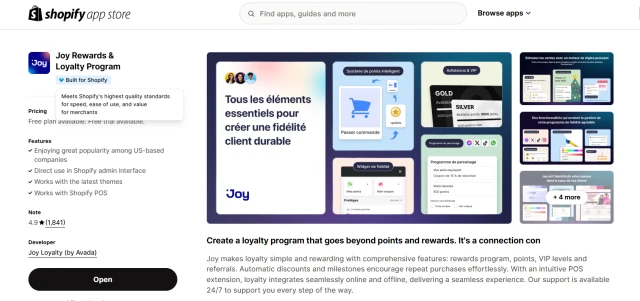
Read more: Explore Joy Loyalty’s New Features & Improvements
One of the best ways to avoid loyalty program mistakes is by choosing a trusted and reliable solution. That’s where Joy Loyalty stands out.
If you’ve ever struggled with low engagement, high costs, or outdated tools, you’re not alone. But Shopify Joy makes it simple. It’s built to help you create a loyalty program that’s easy to manage and exciting for your customers.
Here’s why Joy Loyalty reduces the risk of loyalty program failure:
- Personalized rewards keep customers engaged: Joy Loyalty allows you to create tailored rewards and experiences that align with your audience’s preferences, behaviors, and needs. Personalized offers make customers feel valued, encouraging long-term engagement.
- Gamification drives participation: Joy Loyalty incorporates gamified features, such as earning points for specific actions like writing reviews, referring friends, engaging on social media, unlocking rewards, or reaching milestones. These interactive elements motivate customers to participate actively and return frequently.
- Cost-effective management: Joy Loyalty streamlines program management by automating key processes, such as point tracking, customer segmentation, and reward delivery. Its integration with Shopify further reduces the need for additional tools or workforce, saving time and money.
- Seamless Shopify integration prevents technical hurdles. Joy Loyalty is built specifically for Shopify and integrates effortlessly with your existing store. This eliminates compatibility issues, minimizes downtime, and ensures a smooth experience for you and your customers.
- Real-time analytics for continuous improvement: Joy Loyalty provides real-time analytics and reporting, helping you understand customer behavior, measure ROI, and optimize your strategy over time.
Key Features
Loyalty Page Feature
The Loyalty Page in Joy’s Loyalty Program is a dedicated section on your website that educates customers about your loyalty program and encourages participation. It’s designed to be user-friendly and informative, ensuring customers understand how to earn and redeem points and the benefits of joining.
Key Components of the Loyalty Page:
- Hero Banner: Customize the top section of the page with images and messages that reflect your brand and loyalty program.
- “How It Works” Block: Provide a clear, step-by-step explanation of your loyalty program, typically broken down into three steps: Join, Earn, and Spend.
- “Ways to Earn” Block: Detail how customers can earn points, such as making purchases, signing up, or engaging on social media.
- “Ways to Redeem” Block: Explain how customers can use their accumulated points, whether for discounts, free products, or other rewards. Like the “Ways to Earn” block, it updates automatically based on your configurations.
- FAQs Section (Optional): Address common questions, clarifying aspects like point expiration, checking balances, and program terms.

Image: Loyalty Page showcases rewards, points, and tiers to boost customer engagement and loyalty
Referral Block
Referral Block is a new feature on Joy Loyatly’s page that allows customers to share their unique referral links directly on social media platforms such as Facebook, Twitter, WhatsApp, and Email.

Image: Customers easily share their referral links to boost engagement and expand your customer base
Here’s how the referral program helps reduce the loyalty program failure:
- Customizable rewards: Set specific incentives for the referrer and the new customer, such as points, discounts, or exclusive offers, to motivate participation.
- Anti-Fraud Measures: Joy’s referral system includes anti-cheat features to prevent fraudulent activities, ensuring the integrity of your program.
- Integration with Loyalty Page: Incorporate the referral block into your loyalty page to provide a centralized location for customers to manage and track their referrals.
Types of Loyalty Programs

Image: Joy Loyalty Program: Engage customers with rewards and gift card types
Shopify Joy offers a variety of loyalty programs to fit different business models, including Rewards Programs, Memberships, VIP Levels, Sponsorships, Subscriptions, Gift Card Programs, and Personalized Programs. This range allows businesses to select the program that best aligns with their target audience and goals.
Whether you want to engage customers with points-based rewards or provide exclusive VIP access, Shopify Joy offers customizable options to meet diverse needs.
Types of Rewards
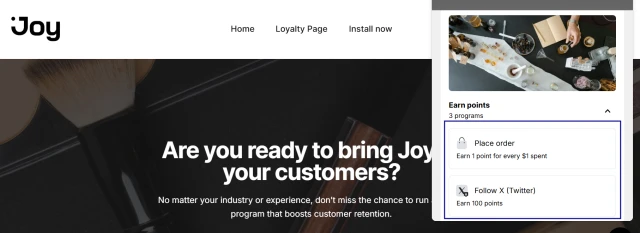
Image: Customers can easily earn points from Shopify joy rewards such as discounts, coupons, cash back, PDV, and more
With Shopify Joy, businesses can offer a variety of rewards to ensure their loyalty program resonates with customers. Options include Points, Discounts, Coupons, Cash Back, PDV Rewards, Free Shipping, Free Products, Exclusive Access, and more. This diverse range of rewards helps boost customer engagement and retention, making the program more appealing and personalized to customer preferences.
Types of Discounts
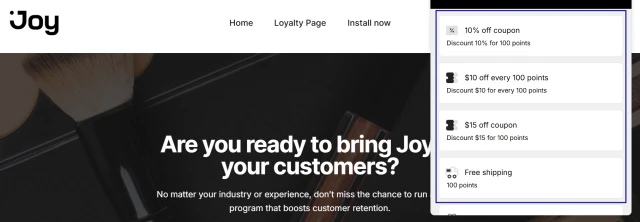
Image: Shopify Loyalty App provides different sales strategies for numerous businesses to target customers
Shopify Joy enables businesses to offer various discounts, including Discount Codes, Coupons, Tiered Pricing, Flat Rate Discounts, Percentage Discounts, and more. With customizable features such as Wholesale Discounts and Limited-Time Offers, Shopify Joy supports different sales strategies, whether it’s a flash sale or a long-term discount structure. This flexibility allows businesses to effectively target customers with the right offer at the right time, enhancing customer satisfaction and sales performance.
Discount Management
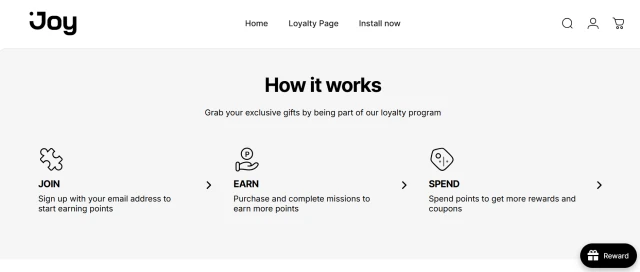
Image: Discount applying is easy for customers to estimate discount and points
Shopify Joy also offers robust tools for efficient discount management. The platform’s discount management system includes features such as Import and Export options, Custom Codes, Campaigns, Triggers, rules, and the ability to accumulate discounts.
Additionally, detailed reports and data analysis are provided to track the performance of discounts, helping businesses optimize their strategies and achieve better results. This seamless management system is ideal for businesses aiming to streamline their promotional efforts while maximizing customer engagement.
Bottom Line
Loyalty programs are all about creating meaningful connections with your customers. If you want to stand out in a crowded market, you must offer value, keep up with tech trends, and make your customers feel like they’re part of something bigger. With tools like Shopify Joy, you can take your loyalty program to the next level, turning engagement into long-term loyalty and boosting your brand’s bottom line.
Why Loyalty Programs Fail: FAQs
Why do most loyalty programs fail?
Most loyalty programs fail because they don’t offer enough value or stand out. Outdated tech, poor communication, and high costs also make them ineffective.
What are the disadvantages of loyalty programs?
They can be expensive and hard to maintain. If rewards don’t match customer needs or feel meaningful, they can backfire and drive disengagement.
Why do people leave loyalty programs?
Customers abandon loyalty programs when rewards don’t justify the effort or lack sufficient value. Complexity, usability issues, and inadequate benefits lead to opt-outs. Poor communication and lack of personalization also play a role in churn.
Why is loyalty decreasing?
Loyalty is dropping because consumers have too many options and crave personalized, meaningful experiences. Brands that don’t adapt to lose their attention.
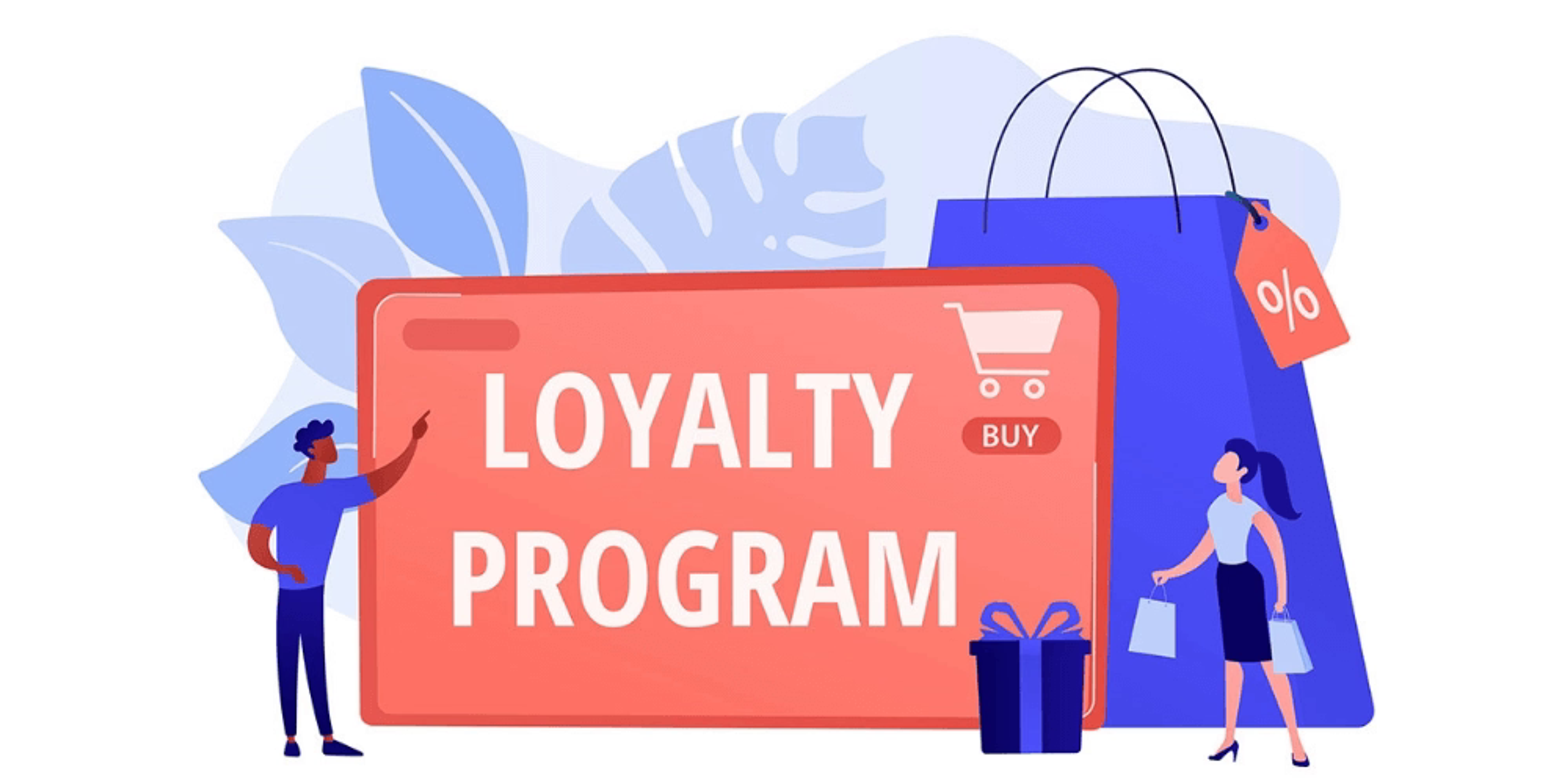

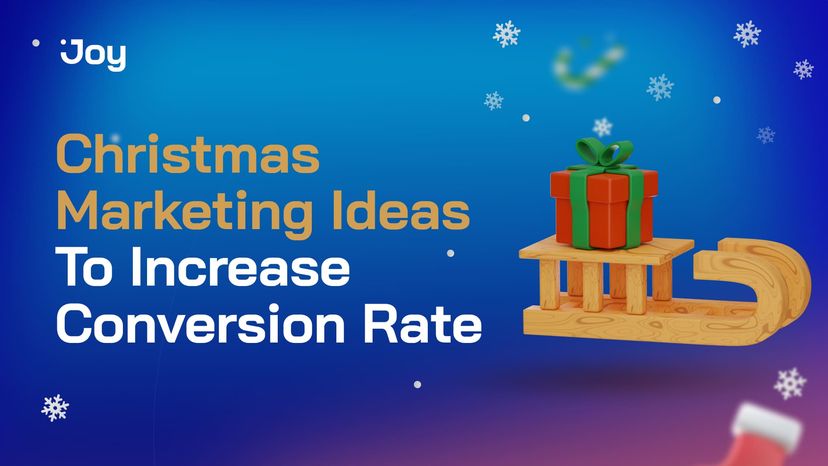

-a7e9a3.png?width=828&q=75&f=webp&auto=format)